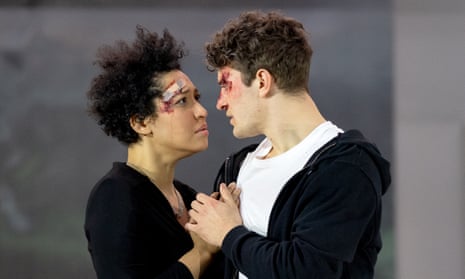The Royal Opera House recently emailed some well-intentioned content advice to people who’d bought tickets for its production of Handel’s oratorio, Theodora, first performed in 1750.
The new staging, “by the ever-radical Katie Mitchell”, would feature, it said, “explicit presentation of scenes of sexual violence, harassment and exploitation and [the] evocation of themes of terrorism”. This thrilling information was sent to hardened opera fans probably accustomed to watching, for instance, young women being stabbed to death in sacks, or abducted, betrayed or left behind in the underworld, or, taking the initiative, killing an unwanted bridegroom in a sea of blood. Maybe it was inevitable that when Theodora opened last week some studiously unruffled spectators couldn’t help comparing the actual proceedings with its advertised potential to traumatise. “This isn’t the shocking staging we were promised,” was the headline of one review.
As writers of trigger warnings will know, there is a definite art to it, starting with the seemingly arbitrary business, as above, of what to warn about. Then, since triggers within a single text might range from, say, “blood” to “classism” by way of “sexual assault”, “hateful language” and “death or dying”, the professional warner must decide how many warnings is too many. In the case of Romeo and Juliet, the Globe theatre was willing to overlook the statutory rape but mentioned “references to drug use”, along with stage blood, gun shots and suicide.
Supposing it’s a good idea, as academics at Royal Holloway have reportedly decided, to warn MA students that Oliver Twist is replete with child abuse, domestic violence and racism, was it right to leave out the casual cruelty to animals, not only to Bill Sikes’s miserable dog, Bull’s-eye? “Mr Gamfield growled a fierce imprecation on the donkey, generally, but more particularly on his eyes; and, running after him, bestowed a blow on his head, which would inevitably have beaten in any skull but a donkey’s.”
Challenged on the Twist warning, Royal Holloway told the Mail on Sunday that the use of content warnings is “standard and accepted practice within academia”, part of its “responsibility to support the mental health and wellbeing of our students” and exists “to educate and inform students in advance around potentially sensitive topics which could cause them anxiety or distress, perhaps as a consequence of past experience”. Or to put it another way, its Twist warning was no more absurd than those others that UK universities have recently applied to work including Jane Eyre, Nineteen Eighty-Four and a children’s book BA module featuring JK Rowling’s Harry Potter and the Philosopher’s Stone. In which, as many 10-year-olds are aware, the child hero starts at wizard school. Older students are advised to tell tutors “if anything is particularly difficult because of its personal relevance”.
The presumption that students should be protected from literature-induced discomfiture has been criticised and ridiculed, to strikingly little effect, since trigger warnings began to proliferate in the US, around 2015. The wider application of a term previously used therapeutically in connection with trauma survivors was defended by academics such as the philosophy professor Kate Manne, writing in the New York Times: “It is to allow those who are sensitive to these subjects to prepare themselves for reading about them and better manage their reactions.” That such students might routinely view content ranging from Netflix’s blood, gun and drug-reference-rich offerings to news reports about real child murder, catastrophe and genocide is no reason, to such teachers, to downplay the discomfort brought on by a made-up story about a 19th-century governess.
From a teacher’s point of view, perhaps such warning-heightened engagement is easier to deal with than the kind of response that Bernardine Evaristo – and many others – have had to Virginia Woolf: “I didn’t connect with her at all.” That Jacob Rees-Mogg reflexively denounces trigger warnings – “universities should just grow up a bit” – is a further reminder that excessive feeling is generally preferable to none. Plus, sometimes you can see the point. Many students must be stunned, even as they expect it, by the racism with which much of the western literary canon is infected. It’s still a shock, going back to Oliver Twist, to see Dickens interspersing passages of deep fellow feeling with those in which Fagin is repeatedly “the Jew”. Nor is this generation the first to recoil. A Jewish mother wrote to Dickens in 1863, inviting him to “atone for a great wrong”.
More recently, it’s regrettable to some of us that the traumatising potential of some fiction never stopped Lord of the Flies and Of Mice and Men being considered ideal introductions, for 12-year-olds, to man’s inhumanity to man. Samuel Whiskers, too, might benefit from a content warning, not for triggering infant panic attacks, but for gifting them a lifetime’s flashbacks to a scuttling rat and a kitten shrouded in dough.
In fact, the commonest objection to trigger warnings, that they will cultivate generations of fragile, censorious victims, could be less effective in reversing them than growing evidence that, regardless of the benefits claimed, they are pointless. When theatres and universities defend them as standard practice they don’t merely lack proof of efficacy, or any coherent system of application, they ignore academic findings that trigger warnings have no effect on anxiety and do not alleviate negative emotional reactions. Warnings may even, in the case of trauma survivors, make things worse. “We found,” one study reports, “substantial evidence that trigger warnings countertherapeutically reinforce survivors’ view of their trauma as central to their identity.”
So long as intentionally disturbing literature is understood as a threat to student wellbeing, it looks as if academics need to find some other therapeutic approach. Of course it wouldn’t work for everyone, but after a few minutes with the snuff offerings at MailOnline they might turn to Bill Sikes with relief.

